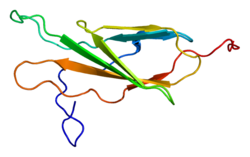EPH receptor A1
Izgled
(Preusmjereno sa stranice EPHT)
| edit |
| EPH receptor A1 | |||||||||||
|---|---|---|---|---|---|---|---|---|---|---|---|
 PDB prikaz baziran na 1x5a. | |||||||||||
| Dostupne strukture | |||||||||||
| 2K1K, 2K1L, 3HIL, 3KKA | |||||||||||
| Identifikatori | |||||||||||
| Simboli | EPHA1; EPH; EPHT; EPHT1 | ||||||||||
| Vanjski ID | OMIM: 179610 MGI: 107381 HomoloGene: 3835 GeneCards: EPHA1 Gene | ||||||||||
| EC broj | 2.7.10.1 | ||||||||||
| |||||||||||
| Pregled RNK izražavanja | |||||||||||
 | |||||||||||
| podaci | |||||||||||
| Ortolozi | |||||||||||
| Vrsta | Čovek | Miš | |||||||||
| Entrez | 2041 | 13835 | |||||||||
| Ensembl | ENSG00000146904 | ENSMUSG00000029859 | |||||||||
| UniProt | P21709 | Q60750 | |||||||||
| Ref. Sekv. (iRNK) | NM_005232 | NM_023580 | |||||||||
| Ref. Sekv. (protein) | NP_005223 | NP_076069 | |||||||||
| Lokacija (UCSC) | Chr 7: 143.09 - 143.11 Mb | Chr 6: 42.36 - 42.37 Mb | |||||||||
| PubMed pretraga | [1] | [2] | |||||||||
EPH receptor A1 (efrinski receptor 1 tipa A) protein je koji je kod ljudi kodiran EPHA1 genom.[1][2]
Ovaj gen je pripadnik grupe efrinskih receptora iz familije proteinskih turozinskih kinaza. EPH i EPH-srodni receptori uzimaju učešća u posredovanju događaja razvića, posebno u nervnom sistemu. Receptori EPH podfamilije tipično imaju jedan kinazni domen, ekstracelularni region koji sadrži domen bogat cisteinom i dva ponavljanja fibronektinskog tipa III. Efrinski receptori se dele u dve grupe na bazi sličnosti sekvenci njihovih ekstracelularnih domena i njihovih afiniteta vezivanja liganda efrina A i efrina B.[2]
- ↑ Ephnomenclaturecommittee (Sep 1997). „Unified nomenclature for Eph family receptors and their ligands, the ephrins. Eph Nomenclature Committee”. Cell 90 (3): 403–4. DOI:10.1016/S0092-8674(00)80500-0. PMID 9267020.
- ↑ 2,0 2,1 „Entrez Gene: EPHA4 EPH receptor A4”.
- Flanagan JG, Vanderhaeghen P (1998). „The ephrins and Eph receptors in neural development.”. Annu. Rev. Neurosci. 21: 309–45. DOI:10.1146/annurev.neuro.21.1.309. PMID 9530499.
- Zhou R (1998). „The Eph family receptors and ligands.”. Pharmacol. Ther. 77 (3): 151–81. DOI:10.1016/S0163-7258(97)00112-5. PMID 9576626.
- Holder N, Klein R (1999). „Eph receptors and ephrins: effectors of morphogenesis.”. Development 126 (10): 2033–44. PMID 10207129.
- Wilkinson DG (2000). „Eph receptors and ephrins: regulators of guidance and assembly.”. Int. Rev. Cytol. 196: 177–244. DOI:10.1016/S0074-7696(00)96005-4. PMID 10730216.
- Xu Q, Mellitzer G, Wilkinson DG (2001). „Roles of Eph receptors and ephrins in segmental patterning.”. Philos. Trans. R. Soc. Lond., B, Biol. Sci. 355 (1399): 993–1002. DOI:10.1098/rstb.2000.0635. PMC 1692797. PMID 11128993.
- Wilkinson DG (2001). „Multiple roles of EPH receptors and ephrins in neural development.”. Nat. Rev. Neurosci. 2 (3): 155–64. DOI:10.1038/35058515. PMID 11256076.
- Hirai H, Maru Y, Hagiwara K, et al. (1988). „A novel putative tyrosine kinase receptor encoded by the eph gene.”. Science 238 (4834): 1717–20. DOI:10.1126/science.2825356. PMID 2825356.
- Gale NW, Holland SJ, Valenzuela DM, et al. (1996). „Eph receptors and ligands comprise two major specificity subclasses and are reciprocally compartmentalized during embryogenesis.”. Neuron 17 (1): 9–19. DOI:10.1016/S0896-6273(00)80276-7. PMID 8755474.
- Owshalimpur D, Kelley MJ (1999). „Genomic structure of the EPHA1 receptor tyrosine kinase gene.”. Mol. Cell. Probes 13 (3): 169–73. DOI:10.1006/mcpr.1999.0228. PMID 10369740.
- Kalo MS, Pasquale EB (October 1999). „Signal transfer by eph receptors”. Cell and tissue research 298 (1): 1–9. DOI:10.1007/pl00008807. PMID 10502115.
- Coulthard MG, Lickliter JD, Subanesan N, et al. (2002). „Characterization of the Epha1 receptor tyrosine kinase: expression in epithelial tissues.”. Growth Factors 18 (4): 303–17. DOI:10.3109/08977190109029118. PMID 11519828.
- Hillier LW, Fulton RS, Fulton LA, et al. (2003). „The DNA sequence of human chromosome 7.”. Nature 424 (6945): 157–64. DOI:10.1038/nature01782. PMID 12853948.
- Brandenberger R, Wei H, Zhang S, et al. (2005). „Transcriptome characterization elucidates signaling networks that control human ES cell growth and differentiation.”. Nat. Biotechnol. 22 (6): 707–16. DOI:10.1038/nbt971. PMID 15146197.

